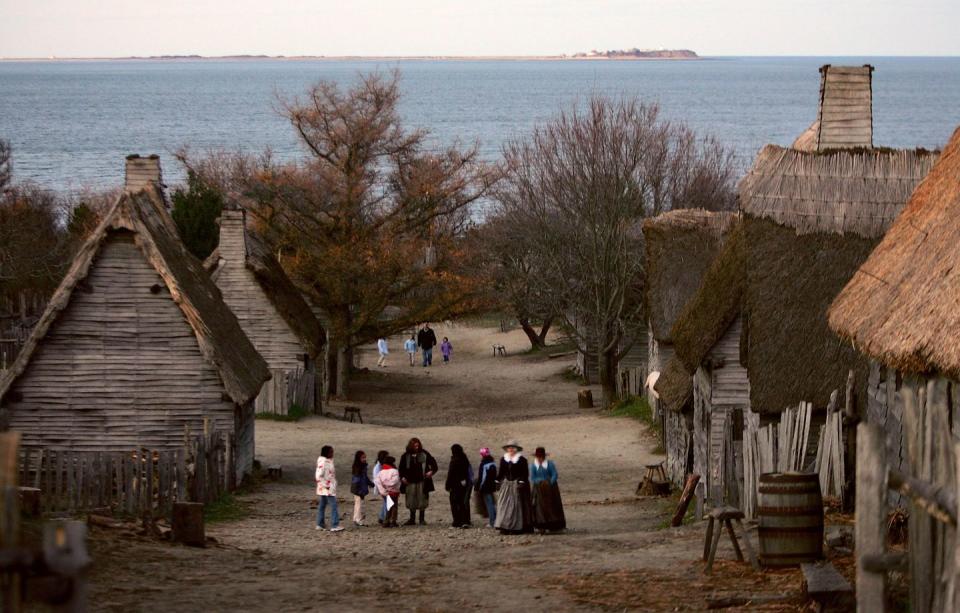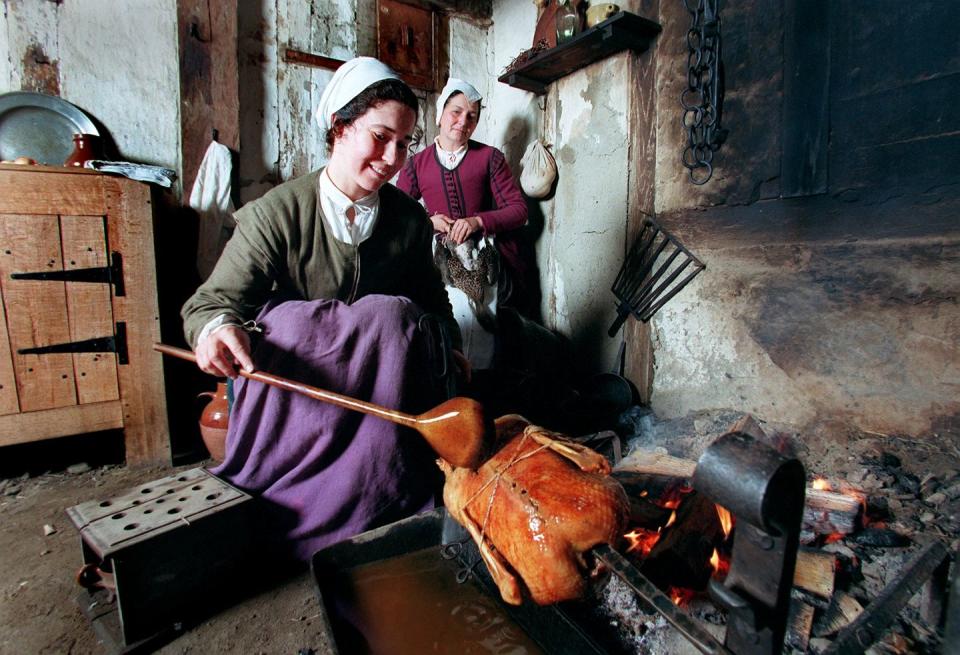When Was the First Thanksgiving? Here's Everything You Need to Know

- Oops!Something went wrong.Please try again later.
- Oops!Something went wrong.Please try again later.
"Hearst Magazines and Yahoo may earn commission or revenue on some items through the links below."
We all know Thanksgiving has something to do with turkey and pilgrims, but when exactly was the first Thanksgiving? Where did it begin, and who celebrated it? Sure we are all about eating our stuffing and pies these days, but what did they feast on back in 1621? And when did these original celebrations of thanksgivings held by English colonists become widely known in what is now the United States? We did the research and are bringing you answers to all of those questions and more to up your Turkey Day history trivia knowledge. Read on for the real history of Thanksgiving celebrations.
When was the first Thanksgiving?
Our story starts with a group of Protestants who had arrived in Plymouth, Massachusetts, in 1620 after leaving their native England after their religious sect that was persecuted there. Their first winter was harsh, but with the help of Squanto, a Native American who spoke English because he had been enslaved, the next season they planted corn and started to fish the land that had belonged to his tribe, the Patuxet, until they were tragically killed by smallpox. Because of all of that, they welcomed a banner harvest in 1621, and they celebrated with three days of feasting from their harvest along iwth food from the Wampanoag tribe (the Patuxet was a band of this larger tribe) along with military demonstrations and games. That very first Thanksgiving took place in 1621 sometime between September and November on Plimouth Planation. (Yes, Plimouth is spelled differently than Plymouth since the original spelling by Governor Bradford was Plimouth with an i instead of a y.)

Whether the Pilgrims invited the native Wampanoag tribe to their feast has been debated, but the Indigenous people likely brought deer and guests to the event. The little we know of those three days comes from this diary entry by Edward Winslow, a leader in the colony:
“And God be praised we had a good increase… Our harvest being gotten in, our governor sent four men on fowling, that so we might after a special manner rejoice together after we had gathered the fruit of our labors. They four in one day killed as much fowl as, with a little help beside, served the company almost a week. At which time, amongst other recreations, we exercised our arms, many of the Indians coming amongst us, and among the rest their greatest king Massasoit, with some ninety men, whom for three days we entertained and feasted, and they went out and killed five deer, which they brought to the plantation and bestowed on our governor, and upon the captain and others. And although it be not always so plentiful as it was at this time with us, yet by the goodness of God, we are so far from want that we often wish you partakers of our plenty.”
Edward Winslow, Mourt’s Relation: D.B. Heath, ed. Applewood Books. Cambridge, 1986. p 82
The centuries that would follow would not exactly be peaceful between the Indigenous tribes and colonists in North America. As the years went by, other days of thanksgiving were called for— sometimes on not-so-peaceful occasions, like colonists returning safely after massacring the Indigenous people living in village, 16 years after that initial feast of thanksgiving—but the story we were taught as schoolchildren of the annual peaceful breaking of bread between colonists and Indigenous tribes didn't come around until the late 19th and early 20th centuries, when Americans began to call for a stronger national identity, a task made easier with a wholesome story to celebrate. The holiday grew to embody the morals that Americans wanted to uphold and promote through an annual meal of gratefulness and plenty.
Who attended the first Thanksgiving?
As you can gather from Winslow’s diary entry, the guest list for the first Thanksgiving ended up with more Wampanoag tribe members than Pilgrims (very different from the many artistic portrayals of the event), as the population of 100 colonists had been cut in half by a harsh winter. Unfortunately, 78 percent of the women died during that first winter, so the event was heavy on the masculine as well, with there ultimately being 22 men, 4 married women (including Edward Winslow’s wife), and more than 25 children and teenagers. This didn’t leave a lot of skilled people to prepare the meal, so we can guess that in addition to the 4 remaining women, children, servants, and unmarried men helped to cook the first Thanksgiving for honored guests like King Massasoit and his 90 men.

What was on the menu at the first Thanksgiving?
So what did this rag-tag kitchen crew cook up during those fateful three days? From the journal entries of both Winslow and Gov. William Bradford, we can gather that there was a lot of fowl, but whether or not there was actually a turkey on the first Thanksgiving is unknown. Food historians say that it likely was a lot of duck, geese, swan, chicken, and pigeon, which they would put on a spit and roast over the fire. We know that the Wampanoag brought venison and likely items from their harvest, which included things like nuts, beans, pumpkins, and squash. The Pilgrims had been shown how to grow corn by the Wampanoag, so there was lots of corn as well as cornmeal for things like porridge. Because there was no butter or flour, there were no pies, tarts, or bread like the colonists were used to, but they used onions and herbs to stuff the birds and may have even had garlic and carrots. Because this was a three-day affair, it’s assumed that they would have taken the carcasses of the eaten birds and boiled them to make stock in order to make porridge for additional meals throughout the celebrations.
In addition, so close to the sea, they had a plethora of shellfish, oysters, eels, lobster, and fish at their disposal and probably served smoked shellfish to their guests. Unfortunately, they didn’t have potatoes or sweet potatoes because those hadn’t come up from South America yet, and while plain cranberries may have been part of the meal, cranberry sauce as we know it wouldn’t be a thing for another 50 years. Much of what we know as our modern-day Thanksgiving meal has been taken from many different cultures with small pieces of that original event included.
When was Thanksgiving made a national holiday?
The harvest event at Plimouth was sadly only a one-time affair, and it wouldn’t be until 1863 that President Lincoln would declared it a national holiday.
Despite its differences from today’s affair, there are still many opinions about how to celebrate Thanksgiving. For some it’s a celebration of coming together in the midst of a harsh environment, while for others its a reminder of the harsh history in our nation's past treatment of Indigenous peoples. Wherever you land, remember that both the colonists and Wampanoag have histories of celebrating harvests throughout the ages, giving thanks to God, the earth, or to whoever was worshipped for what they had grown and would hopefully sustain them through the winter. Counting one’s blessings, however small, is something that definitely embodies the spirit of the first Thanksgiving.
You Might Also Like

